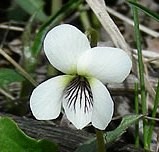Primrose-leaf violet
(Viola inconspicua)

Description
Viola primulifolia, commonly called the primrose-leaf violet, is a species of flowering plant in the violet family. It is native to eastern North America, and possibly also to the Pacific Northwest. Its natural habitat is wet acidic areas that are usually at least semi-open. It is a low, stemless perennial that produces white flowers in the spring. It can be distinguished from the similar-looking Viola lanceolata and Viola blanda by its leaves that are ovate, with rounded to truncate bases, and are 1.5-2 times as long as wide. While typical Viola primulifolia occurs in a large area of the east, a variety of this species is sometimes credited to occur in a small area of western California and Oregon, under the name of V. primulifolia var. occidentalis. These populations, which are considered rare and highly localized, have alternatively been referred to as Viola lanceolata ssp. occidentalis. Viola is a genus of flowering plants in the violet family Violaceae. It is the largest genus in the family, containing between 525 and 600 species. Most species are found in the temperate Northern Hemisphere; however, some are also found in widely divergent areas such as Hawaii, Australasia, and the Andes. Some Viola species are perennial plants, some are annual plants, and a few are small shrubs. Many species, varieties and cultivars are grown in gardens for their ornamental flowers. In horticulture the term pansy is normally used for those multi-colored, large-flowered cultivars which are raised annually or biennially from seed and used extensively in bedding. The terms viola and violet are normally reserved for small-flowered annuals or perennials, including the wild species. Annual or perennial caulescent or acaulescent (with or without a visible plant stem above the ground) herbs, shrubs or very rarely treelets. In acaulescent taxa the foliage and flowers appear to rise from the ground. The remainder have short stems with foliage and flowers produced in the axils of the leaves (axillary). Viola typically have heart-shaped or reniform (kidney-shaped), scalloped leaves, though a number have linear or palmate leaves. The simple leaves of plants with either habit are arranged alternately; the acaulescent species produce basal rosettes. Plants always have leaves with stipules that are often leaf-like. The flowers of the vast majority of the species are strongly zygomorphic with bilateral symmetry and solitary, but occasionally form cymes.
Taxonomic tree:







